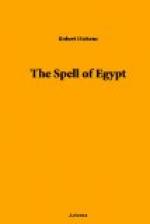Come to this temple when you leave the hall of Seti. There you are in a place of triumph. Scarlet, some say, is the color of a great note sounded on a bugle. This hall is like a bugle-call of the past, thrilling even now down all the ages with a triumph that is surely greater than any other triumphs. It suggests blaze—blaze of scarlet, blaze of bugle, blaze of glory, blaze of life and time, of ambition and achievement. In these columns, in the putting up of them, dead men sought to climb to sun and stars, limitless in desire, limitless in industry, limitless in will. And at the tops of the columns blooms the lotus, the symbol of rising. What a triumph in stone this hall was once, what a triumph in stone its ruin is to-day! Perhaps, among temples, it is the most wondrous thing in all Egypt, as it was, no doubt, the most wondrous temple in the world; among temples I say, for the Sphinx is of all the marvels of Egypt by far the most marvellous. The grandeur of this hall almost moves one to tears, like the marching past of conquerors, stirs the heart with leaping thrills at the capacities of men. Through the thicket of columns, tall as forest trees, the intense blue of the African sky stares down, and their great shadows lie along the warm and sunlit ground. Listen! There are voices chanting. Men are working here—working as men worked how many thousands of years ago. But these are calling upon the Mohammedan’s god as they slowly drag to the appointed places the mighty blocks of stone. And it is to-day a Frenchman who oversees them.
“Help! Help!
Allah give us help!
Help! Help!
Allah give us help!”
The dust flies up about their naked feet. Triumph and work; work succeeded by the triumph all can see. I like to hear the workmen’s voices within the hall of Seti. I like to see the dust stirred by their tramping feet.




